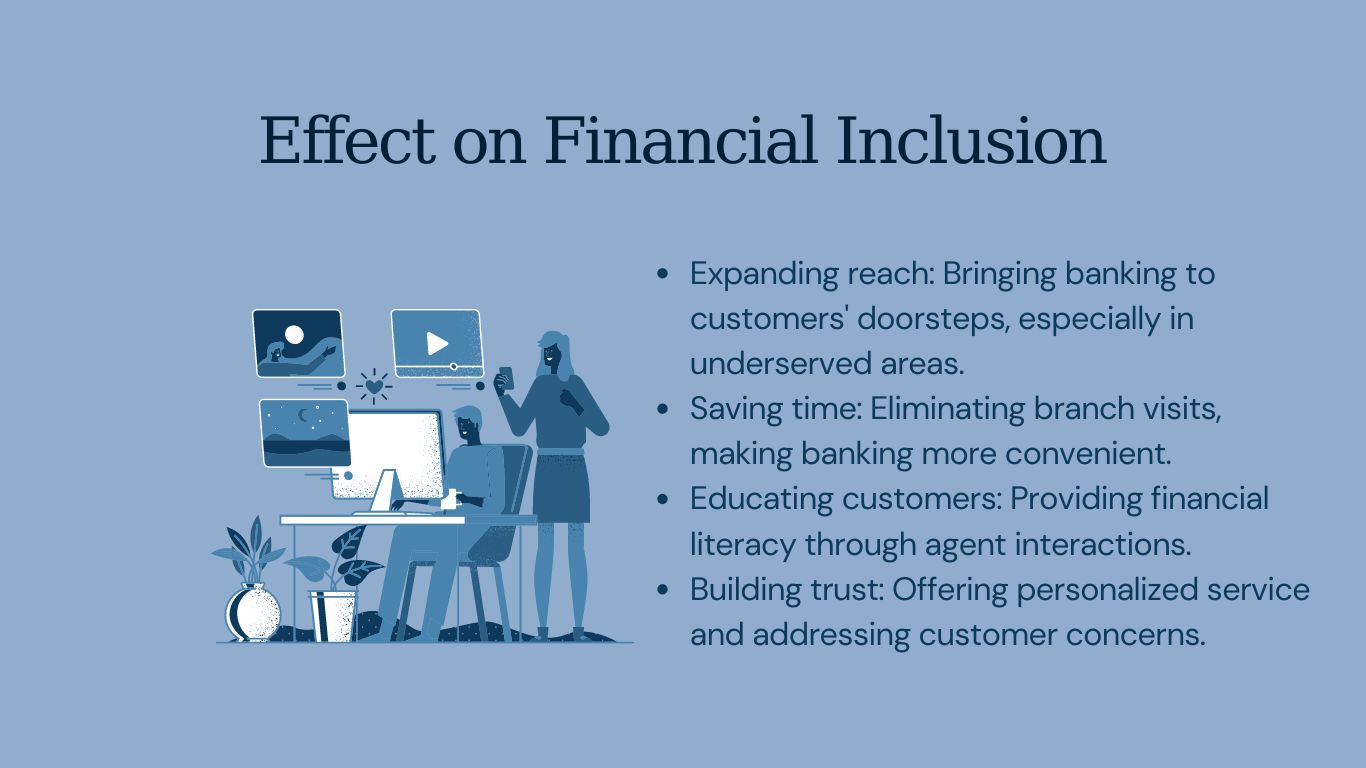Digital Technology is Powering Doorstep Banking

The financial services industry is changing quickly, and digital technology is having a significant impact on it. Because of this, doorstep banking is revolutionizing the sector. Understanding how digital developments are enabling financial services to be delivered directly to consumers’ homes requires reading this post. It improves security, accessibility, and ease of use.
We gain important insights by investigating the developments that caused this trend. In addition to transforming client experiences, doorstep banking is essential to increasing financial inclusion. It is also accelerating economic growth.
You risk missing out on important chances if you don’t understand the ramifications of doorstep banking. This information is crucial for financial management in both personal and business contexts. If you don’t have it, you might not be ready for the efficiency and ease that come with contemporary banking solutions. As a result, you may lag behind in a financial environment that is becoming more and more competitive.
Furthermore, there may be wasted opportunities if the significance of these breakthroughs is not understood. It is imperative to enhance financial inclusion and leverage rising market trends. Being informed is therefore essential.
The dynamic nexus between doorstep banking and digital technologies will be examined in this article. This trend is being driven forward by innovations like blockchain, biometrics, artificial intelligence, and mobile apps. To illustrate these ideas, we will look at case studies from different geographical areas.
We will also discuss the advantages and difficulties of doorstep banking. Additionally, insights into upcoming trends influencing the market will be given. You will obtain a thorough knowledge of how doorstep banking is set to revolutionize financial services by reading this extensive overview. Navigating the future of banking requires being knowledgeable.
Handling Doorstep Banking
Rising in the financial sector, doorstep banking involves offering banking services right to consumers’ homes or businesses. Eliminating consumers’ need to physically visit bank premises, this inventive approach provides unsurpassed simplicity and accessibility. From loan applications and cash withdrawals to account opening and balance questions, a whole spectrum of banking services can be right at the customer’s door.
Technology’s Purpose
Doorstep banking is built on digital technology. Technology working together powers this service:
- Mobile Apps: Usually acting as the main point of contact between the customer and the bank are these. Strong mobile apps allow flawless account administration, customer service, and transactions.
- Biometrics: In banking, security takes precedence. Fingerprint, facial recognition, and iris scanning, among other biometric authentications, guarantee safe access to transactions and accounts.
- Artificial Intelligence and Machine Learning: By means of tailored recommendations, fraud detection, and effective service delivery, artificial intelligence and machine learning improve customer experience.
- GPS and Geolocation: Agent management and service scheduling depend on exact location monitoring.
- Payment Gates: Transactions depend on safe processing of payments.
Doorstep Banking Case Studies
Diverse areas have effectively used doorstep banking:
- India: To service underprivileged and rural areas, banks there have embraced doorstep banking. Key in financial inclusion have been services including account opening, cash deposits, and withdrawals.
- Africa: Especially in microfinance and mobile banking, countries like Kenya and Nigeria have seen the expansion of doorstep banking. This has enabled people and small companies.
- China: Chinese banks provide a flawless shopping and payment experience by including e-commerce platforms into their doorstep banking systems.
Advantages of Digital Doorstep Banking
Digital doorstep banking brings many advantages:
- Customer Convenience: Services are offered from home; there is no need to visit the bank.
- Enhanced Security: Advanced encryption and authentication techniques protect transactions.
- Reaching Far-off Areas: Reaches consumers in far-off areas who might not have access to physical branches in rural and underserved areas.
Possibilities and Challenges
Although doorstep banking presents great possibility, it also presents difficulties:
- Infrastructure: Effective application depends on dependable digital literacy and internet connection.
- Security: First concern is keeping consumer information safe from online hazards.
- Agent Network: It is absolutely vital to create and oversee a reliable banking agent network.
- Regulatory Compliance: Operating under a distributed architecture might make following banking rules challenging.
Notwithstanding these obstacles, the chances are great:
- Financial Inclusion: Doorstep banking helps to close the disparity between unbanked groups and conventional banks.
- Improved Convenience and Individualized Service: Help to increase consumer loyalty.
- Cost Efficiency: Less physical branches mean fewer overhead expenditures, enhancing profitability.
- New Income Sources: Direct client engagement facilitates cross-selling of goods and services, therefore generating new income sources.

Effect on Financial Inclusion
Getting to the Underbanked
Door-to-door banking is revolutionizing the search for financial inclusion. Directly delivering banking services to people’s homes helps to remove some obstacles experienced by the unbanked population:
- Geographical Accessibility: For people who live in rural or isolated places, traditional banking can be difficult since clients must often drive long distances to access a branch. Doorstep banking removes this obstacle.
- Time Constraints: Many people—especially those in the informal or agricultural sectors—have little time to visit bank branches. Doorstep banking fits their calendar.
- Literacy and Numeracy: Many times, the unbanked struggle with financial literacy. Agents from doorstep banks can offer simple financial advice and support.
- Trust and Familiarity: Formal financial institution building can be challenging. A personalized approach to doorstep banking helps to build trust.
Financial Inclusion: Economic Growth
Driven by services like doorstep banking, increased financial inclusion helps to greatly stimulate economic growth:
- Savings: People who have access to savings accounts are more inclined to save, therefore generating a pool of money for lending and investment.
- Credit Access: Doorstep banking helps individuals and small enterprises to get loans, therefore encouraging economic activity and entrepreneurship.
- Promoting Digital Transactions: Helps doorstep banking to lower dependency on cash, thereby enhancing efficiency and transparency.
- Access to Insurance Products: Helps people and companies guard against unanticipated financial losses.
- Social Safety Nets: By means of bank accounts, government funds can be distributed more precisely, therefore reaching people in need.
Statistical Reflections
Numbers clearly show the emergence of digital banking:
- Development of Digital Banking Users: A recent poll indicates that 15% more people use digital banking last year.
- Enhanced Transactions via Digital Platforms: A 25% increase in digital transactions indicates an obvious inclination for online services.
- Customer Satisfaction Rates: Digital banking users have an 85% satisfaction rate according to surveys, therefore stressing the success of these projects.
Government Programs Supporting Doorstep Banking
Acknowledging the ability of doorstep banking to promote financial inclusion, several governments are putting encouraging measures into effect:
- Simplifying Rules: Governments are simplifying rules for doorstep banking companies, thereby providing enabling conditions. This can entail simplifying operating rules, lowering capital needs, and expediting licensing processes.
- Programs for Financial Literacy: By means of financial education, one can enable individuals to make wise decisions around borrowing, saving, and money management. Government programs might call for financial literacy seminars, public awareness campaigns, and local language translations of instructional resources.
- Growing Internet and Mobile Connectivity: Success of doorstep banking depends on growing internet and mobile connectivity. Governments can fund public-private cooperation for network growth, infrastructure development, and low-income populations’ data costs subsidization.
- Public-private Partnerships: Public-private partnerships between governments and businesses help to hasten the acceptance of doorstep banking. Governments should use technology businesses to produce creative doorstep banking solutions, give banks and financial institutions incentives to extend their services to underprivileged areas, and offer training programs for banking agents.
- Incentives: Governments can provide banks and other financial companies incentives to increase their doorstep banking offerings. These incentives can be grants, tax rebates, or subsidies for the acceptance of technologies, among other forms.
Doorstep banking has the ability to change lives and businesses by tackling the problems the unbanked experience and using technology’s capabilities.
To get more knowledge about activities regarding Finance then click here.
Doorstep Banking: Security and Privacy
Dealing with Client Anxiety
Data security is one of main issues with doorstep banking. Banks are acting in numerous ways to help to reduce these worries:
- Strong Encryption: Using cutting-edge technologies to protect consumer information both in use and in flight.
- Biometric Verification and Multi-factor Authentication: Using biometric verification and multi-factor authentication will help to guard account access.
- Data Minimizing: Safely storing just the required data for a limited period.
- Open Communication: Tell consumers exactly about security policies and data management techniques.
- Incident Response Planning: Creating thorough strategies to handle data breaches and reduce their effects is part of incident response planning.
- Customer Education: Equipping consumers with awareness of cybersecurity best practices—that is, phishing efforts and personal information protection—should empower them.
The Function of Authorities
Ensuring the security of doorstep banking depends much on regulatory agencies since they:
- Data Protection Rules: Putting strict data protection rules into effect to defend consumer data. These rules specify the kinds of information that can be gathered, how it has to be kept and used, and consumer rights to access and control their information.
- Cybersecurity Guidelines: Establishing industry-wide cybersecurity guidelines to which banks have to follow. These guidelines outline the technical and organizational measures banks must employ to guard client data from illegal access, use, disclosure, disturbance, alteration, or destruction.
- Compliance Examination: Examining banks’ security measure compliance on a regular basis helps. This guarantees that banks are acting correctly to safeguard consumer data and helps to spot any flaws in their security systems.
- Enforcing Severe Fines: Enforcing severe fines for violations of cybersecurity rules and data protection standards. This encourages banks to make strong security investments by deterring their neglect of their responsibilities.
- Safeguarding Consumer Rights: Safeguarding consumer rights and interests by means of well-defined rules and dispute-resolution systems. This guarantees that should data be hacked or exploited, consumers have rights.
Optimal Guidelines for Banks
Banks can implement these best practices to improve security:
- Employee Training: Teaching every staff member thorough cybersecurity including awareness of phishing attacks and social engineering techniques.
- Frequent Security Assessments: Frequent security assessments help to find and fix vulnerabilities through penetration testing and vulnerability assessments.
- Risk Management Framework: Adopting a strong risk management system can help you spot, evaluate, and lessen security concerns.
- Third-Party Risk Management: To safeguard private information, carefully screen and watch over outside service providers.
- Incident Response Strategies Testing: Testing incident response strategies often helps to guarantee their success.
- Constant Monitoring: Using cutting-edge instruments to instantly identify and handle risks.
- Data Loss Prevention Techniques: Using data loss prevention techniques helps to stop illegal data flow.
- Physical Security: By means of access restrictions, monitoring, and safe disposal of sensitive records, one protects physical access to consumer data.
Giving data security and privacy first priority will help banks maintain their reputation and gain confidence from their clients.

Doorstep Banking Future Trends
Future Technologies
The direction of doorstep banking is absolutely dependent on technical developments.
- Blockchain: Through increased security, openness, and efficiency, this distributed technology can transform doorstep banking. Smart contracts for automated service delivery, identity verification, and safe transaction processing can all be accomplished with it.
- IoT: Devices of the Internet of Things can be combined to provide a more linked banking experience. For biometric authentication, for example, smart home appliances can be employed; wearable gadgets can enable contactless payments.
- Artificial Intelligence (AI) and Machine Learning: Provide risk assessment, fraud detection, and customer service enhancement. While machine learning algorithms can examine consumer data to deliver tailored recommendations, artificial intelligence-powered chatbots can offer instantaneous help.
- Virtual Reality (VR) and Augmented Reality (AR): Can improve consumer contacts. While VR can create virtual branches for consumers to explore, AR can be utilized to give banking agents visual assistance.
Changing Client Views
Consumers want from doorstep banking more than simply convenience.
- Customized Banking Products: Consumers want customized banking products based on their interests and financial habits. This covers proactive notifications, tailored services, and product suggestions.
- Omnichannel Experience: Perfect merging of digital and physical channels is absolutely vital. Consumers should be able to start a purchase online and finish it either at their door or vice versa.
- Instant Gratification: Clients want speedy and effective service. Important will be real-time transaction processing and instant fund access.
- Hyper-convenience: Consumers will search for extra services, including bill payments, insurance, and investment advice, right at their doorstep, outside of essential banking ones.
The Competitive Terrain
The market for doorstep banking is growingly cutthroat.
- Non-traditional Players: Non-traditional players are causing a major change in the scene of doorstep banking. Giants in technology and fintech organizations are using their agility and technological know-how to provide creative doorstep banking ideas. This forces conventional banks to change and enhance their services to keep competitive.
- Cooperation Among Banks, Fintechs, and Communications Businesses: Another important development changing the competitive scene is cooperation among banks, fintechs, and communications businesses. These alliances can result in the creation of innovative and disruptive company models fit for changing consumer needs. For a mobile app-based doorstep banking platform, a bank might work with a fintech startup; for doorstep banking services via its vast agent network, a telecoms provider could partner with a bank.
Success in this always-changing world will depend on distinction. Banks will have to set themselves apart by giving better customer service, making investments in cutting-edge technologies, and delivering a larger spectrum of goods and services right at the client’s house. Personalized financial advice, wealth management tools, and access to investment products might all fit here.
Ultimately, banks will need to maximize costs if they are to guarantee profitability in the doorstep banking sector. This entails maximizing agent networks to increase effectiveness, using technology to automate tasks, and simplifying operations to cut expenses.
In conclusion, doorstep banking is evolving rapidly, driven by technological advancements and changing customer expectations. Banks that follow these trends and make innovative investments will be positioned to thrive in this very competitive environment.
Difficulties in Doorstep Banking
Though it has advantages, doorstep banking has some difficulties:
- Technological Obstacles: Restricted internet access and insufficient digital literacy in some regions can compromise service delivery.
- Security Issues: Still a major difficulty are cybersecurity concerns.
- Bridging the Digital Divide: Technology Adoption Among Older Adults
Approaches to Overcome Difficulties
Dealing with these issues calls for different approaches:
- Improving Cybersecurity Measures: Teaching consumers about safe behavior and putting strong security systems into use.
- User-friendly Interfaces: Creating all age groups’ easily navigable applications and platforms.
- Educational Initiatives: Giving consumers tools and instruction so they may properly use digital services.
Conclusion
Using digital technology, banks may provide doorstep banking—a service that is quickly becoming rather popular. This innovative approach not only provides unparalleled convenience for customers but also has the potential to drive financial inclusion and economic growth. Even at a customer’s door, digital technology is powering doorstep banking, allowing banks to quickly and safely handle transactions. Moreover, digital technology helps banks to close the distance between conventional banking and people who have hitherto lacked access to financial services by enabling them to reach geographically inaccessible or underdeveloped areas.
